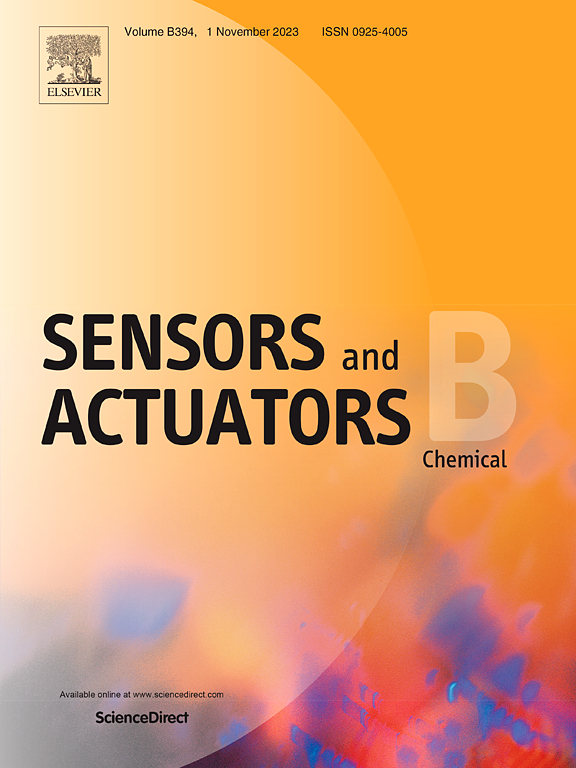具有双锁定线粒体靶向的铱配合物的合理设计,用于动态粘度监测和精确双光子肿瘤成像
IF 3.7
1区 化学
Q1 CHEMISTRY, ANALYTICAL
引用次数: 0
摘要
利用线粒体黏度作为纽带来感知早期肿瘤组织周围的微环境对于肿瘤发生跟踪和肿瘤检测至关重要。然而,目前大多数粘度激活线粒体探针对线粒体膜电位(MMP)的高度依赖以及较短的发光寿命和较差的组织穿透深度严重阻碍了它们的广泛应用。在此,我们报告了一种新的粘度激活双光子磷光探针(Ir-visc),采用双锁定线粒体靶向策略,结合静电力和探针-蛋白质分子对接,能够实时监测癌细胞损伤过程中线粒体粘度的动态变化。该探针在高粘性介质中显示出显著的93倍磷光增强,并且能够通过其双锁定策略对线粒体粘度进行一致和准确的检测,即使在受损的线粒体中也是如此。此外,Ir-visc具有粘度激活双光子吸收(TPA)特性,这使得它很容易与细胞自身荧光区分,同时提高了成像深度和灵敏度。值得注意的是,探针Ir-visc选择性地标记癌细胞,并展示了实时监测线粒体粘度变化的出色能力。这些发现表明,Ir(Ⅲ)复合物探针为研究线粒体粘度和改善癌症诊断提供了一种通用的策略。本文章由计算机程序翻译,如有差异,请以英文原文为准。
Rational design of iridium complex with double-locked mitochondria-targeting for dynamic viscosity monitoring and precision two-photon tumor imaging
Perceiving the microenvironment around early-stage tumor tissue using mitochondrial viscosity as a nexus is crucial for tumorigenesis tracking and tumor detection. However, the high dependence of most current viscosity-activated mitochondrial probes on mitochondrial membrane potential (MMP) as well as short luminescence lifetimes and poor tissue penetration depths have severely hindered their widespread application. Herein, we report a novel viscosity-activated two-photon phosphorescent probe (Ir-visc) employing a double-locking mitochondrial targeting strategy that incorporates electrostatic force and probe-protein molecular docking, enabling real-time monitoring of dynamic changes in mitochondrial viscosity during cancer cell damage. The probe exhibits remarkable 93-fold enhancement of phosphorescence in the presence of highly viscous media and enabling consistent and accurate detection of mitochondrial viscosity, even in damaged mitochondria through its dual-locking strategy. Furthermore, Ir-visc has viscosity-activated two-photon absorption (TPA) characteristics, which makes it easily distinguishable from cellular autofluorescence while enhancing imaging depth and sensitivity. Notably, the probe Ir-visc selectively labels cancer cells and demonstrates excellent capability for real-time monitoring of viscosity changes in mitochondria. These findings suggest that the Ir (Ⅲ) complex probe offers a versatile strategy for studying mitochondrial viscosity and improving cancer diagnosis.
求助全文
通过发布文献求助,成功后即可免费获取论文全文。
去求助
来源期刊

Sensors and Actuators B: Chemical
工程技术-电化学
CiteScore
14.60
自引率
11.90%
发文量
1776
审稿时长
3.2 months
期刊介绍:
Sensors & Actuators, B: Chemical is an international journal focused on the research and development of chemical transducers. It covers chemical sensors and biosensors, chemical actuators, and analytical microsystems. The journal is interdisciplinary, aiming to publish original works showcasing substantial advancements beyond the current state of the art in these fields, with practical applicability to solving meaningful analytical problems. Review articles are accepted by invitation from an Editor of the journal.
 求助内容:
求助内容: 应助结果提醒方式:
应助结果提醒方式:


